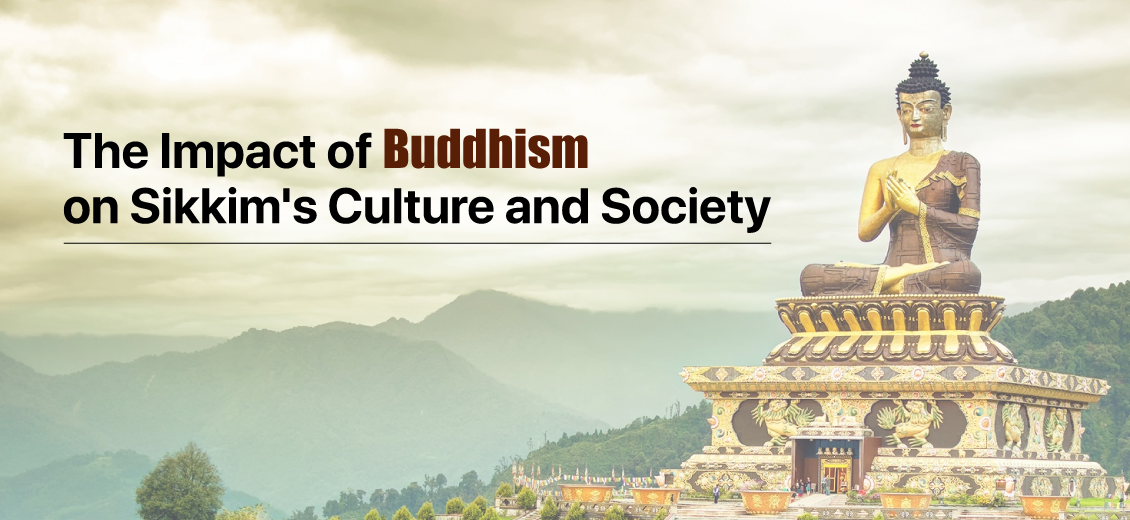The Impact of Buddhism on Sikkim's Culture and Society
Blogs Home
- 16 May 2023

The Namgyal Dynasty established the Kingdom of Sikkim during the 17th century. Sikkim's history had a profound impact due to contact with indigenous Lepcha and early Tibetan settlers. Once an independent Buddhist Kingdom, Sikkim remains deeply influenced by Buddhism, affecting its society and culture to this day. The ethnic landscape in Sikkim has undergone a transformation over the years, primarily due to heavy immigration from Nepal. Presently, Sikkim is a country with a Hindu majority controlled by a Buddhist monarchy and clergy.
In the history of Buddhism in Sikkim, Guru Rinpoche is said to have arrived in 8th century to bless the land and establish the religion of Buddhism. Guru Rinpoche is credited to establish the first monastary in Sikkim, the Dubby Monastery. Guru Rinpoche is revered as a prominent figure in Sikkim’s religious and cultural history.
Studying the impact of Buddhism on Sikkim's culture and society is crucial due to its intriguing history and background. This blog aims to analyze this impact in detail.
Buddhist Art in Sikkim
Buddhist art has a long history in Sikkim, dating back to the 7th century, and it holds a special place among the people. Thangka paintings are among the most prominent Buddhist art forms found in Sikkim. These include two-dimensional wall paintings, three-dimensional wood crafts, masks, and architecture. The paintings mainly depict Buddhist deities and ideologies.
Monks and priests were the pioneers of Buddhist paintings, passing down their talents through generations. Nowadays, monasteries and practitioners greatly benefit from the commercialization of this art form. Buddhist murals employ motifs similar to those used in thangka paintings, but on a larger scale.
Thangka painting is considered the pinnacle of Buddhist art. It adheres to strict iconography rules and follows religious scriptures. Thangkas are regarded as objects of worship and aids in meditation.
Buddhism and the People of Sikkim
Buddhism profoundly impacts the spiritual, cultural, and social aspects of the people of Sikkim. Evidence of this impact is visible in various aspects of society.
At a spiritual level, Buddhism provides people with a path to enlightenment and salvation. Compassion, wisdom, and non-violence lie at the heart of its teachings. Buddha's teachings have guided people to think and act in ways that promote a peaceful and harmonious society. Buddhist teachings have become a source of comfort and solace for the people.
Culturally, Buddhism deeply influences the art, music, literature, and architecture of Sikkim. The state boasts numerous cultural landmarks, beautiful monasteries, and temples. In Sikkim, it is common for every household to have its own shrine, where family idols and sacred items are kept.
Buddhist rituals, culture, and festivals are deeply ingrained in Sikkimese culture, significantly influencing education and social life.
Socially, Buddhism has impacted interpersonal interactions. The Sikkimese people exhibit values of compassion, tolerance, and non-violence, which are promoted by Buddhism. The teachings emphasize the importance of knowledge and education, resulting in Sikkim's literacy rate reaching 81.42 percent in 2023. The literacy rate continues to show an upward trend, as per the latest population census.
Religion has also influenced the cuisine and dietary habits of the Sikkimese people. Many Sikkimese dishes are vegetarian, reflecting Buddhist values of non-violence and compassion towards animals. Non-vegetarian dishes are prepared in a way that respects the animals being consumed.
Literature has been inspired from Buddhism in Sikkim. Many poets, writers in Sikkim have incorpoated themes and ideas in their works. For example, many famous poets wrote various poems inspired from Buddhist philosophy and spirituality. The poems reflect the Buddhist values of compassion, wisdom and non-attachment.
Music has been profoundly affected by Buddhism. Traditional Sikkimese music, performed at Buddhist ceremonies, and festivals, features instruments like Damarua ling all of which are traditional Sikkim instruments. Various songs are based on Buddhist themes and incorporate mantras and chants.
Dance forms like Cham dance is a prime example of how Budhdhism has influenced the dance tradition of Sikkim. Other traditional dance forms like Gha To Kito and Tashi Shilpa incorporates various Buddhist themes and motifs.
Festivals
Buddhism has significantly influenced the festivals and celebrations in Sikkim. Many festivals celebrated in Sikkim have roots in Buddhist traditions, forming an integral part of the state's cultural heritage. Some notable festivals include:
Losar: This festival marks the Tibetan New Year and is widely celebrated in Sikkim. During Losar, people gather, feast, and offer prayers to their deities. The festival has deep roots in Tibetan and Buddhist traditions, and it is believed that celebrating Losar drives away evil spirits and brings good luck.
Saga Dawa: This significant festival commemorates the birth, enlightenment, and death of Lord Buddha. During Saga Dawa, people in Sikkim offer prayers, perform religious rituals, and engage in acts of kindness and generosity.
Bumchu: Celebrated in association with Tashiding Monastery, Bumchu involves the opening of a sacred pot containing holy water, believed to predict the fortunes of the state for the coming year. Bumchu symbolizes unity and harmony between different religious communities in Sikkim, blending Buddhist and Bon traditions.
Guru Rinpoche's Birthday: Celebrated with great devotion in Sikkim, Guru Rinpoche's Birthday honors the founder of the Nyingma school of Buddhism, Guru Rinpoche. He is a revered figure in Tibetan Buddhism. During this festival, people offer prayers, perform religious rituals, and engage in acts of charity and compassion.
Phang Lhabsol: A unique festival that honors the mountain deity, Mount Kanchenjunga, and celebrates the close relationship between the people of Sikkim and the natural environment. This festival blends Buddhist and Bon traditions, and people engage in cultural activities like dance and music while offering prayers and performing religious rituals.
A Neutral Insight
As discussed above, Buddhism has a significant impact on the culture and society of Sikkim. The teachings of Buddha have a positive influence on the people, fostering qualities such as compassion, kindness, and generosity. These values have helped shape a strong moral framework and a sense of community, harmony, and respect for others in Sikkimese society. The impact of Buddhism is evident in the way people in Sikkim approach social issues, such as poverty, education, and healthcare, with a strong emphasis on compassion and social responsibility.
Final Words
Buddhism has had a profound impact on Sikkimese culture and society, playing a significant role in shaping religious beliefs, customs, and traditions. Since its arrival in the 7th century, Buddhism has become the dominant religion in the region. The influence of Buddhism is evident in the numerous monasteries and religious institutions that dot the Sikkim landscape, as well as in the festivals and rituals that form an integral part of Sikkimese life.
Moreover, Buddhism has left a lasting imprint on Sikkim's art and architecture. The intricate murals, thangkas, and sculptures depicting Buddhist deities and teachings in Sikkim's monasteries are renowned. Traditional Sikkimese architecture is heavily influenced by Buddhism, incorporating Buddhist motifs and symbols into its designs. This fusion has created a unique cultural identity deeply rooted in Buddhist tradition.
The impact of Buddhism has been overwhelmingly positive for the state and its people, who uphold strong societal, moral, and ethical values. Sikkim has gained a reputation as a safe place to visit, with helpful locals and a conducive environment for women to travel at night. The cultural practices and values rooted in Buddhism have contributed to shaping a positive image of the Sikkimese people among other parts of the country.
In conclusion, Buddhism continues to shape and enrich the cultural fabric of Sikkim, leaving an indelible mark on its society, art, architecture, and people's way of life.
Shounak Roy
He finds pleasure in the hunt for knowledge, eagerly seeking to learn something new about anything that interests him. He describes himself as a simple and peaceful individual, always curious to delve deeper into various subjects. If he comes across someone with shared interests, he enjoys engaging in discussions and exchanging knowledge.
Blogs Home




